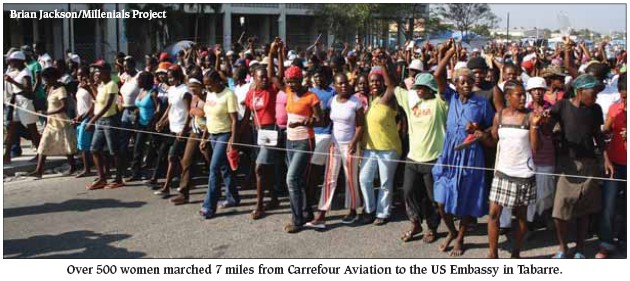|

Christian Guerrier and Brian
Jackson, both based in the Miami,
Florida area, visited Haiti from Feb. 1
- 9. They are with the Millennials Project,
an organization dedicated to the
empowerment of women.
We traveled to Haiti with the idea
that women would emerge to lead
in rebuilding and reshaping the country’s
future after the devastating Jan.
12th earthquake. Arriving by bus from
the Dominican Republic, we stayed in
makeshift tents at Port-au-Prince’s Carrefour
Aviation Base, near the community
of Pont Rouge, where Christian had
lived as a boy.
Prior to our arrival, we had heard
from news reports that women were
having difficulty obtaining the aid that
was being distributed. When we arrived,
it appeared that nobody was receiving
such aid. It was quite clear that the most
pressing need among the hundreds of
thousands of internally displaced was
tents. Having toured much of Port–au–
Prince by car, we had observed no more
than a few hundred tents spread between
a handful of locations. Throughout the
week, we spent the better part of our
time organizing the women at Carrefour
Aviation and going back and forth to
the United Nation’s Mission to Stabilize
Haiti (MINUSTAH) Logistics Base, in the
airport’s northeast corner, where most of
the foreign aid groups were stationed.
We spoke with no less than two dozen
representatives from organizations such
as the UN Children’s Fund (UNICEF),
the UN Refugee Agency (UNHCR), the
International Organization for Migration
(IOM), The Red Cross, the World Health
Organization (WHO) and the UN World
Food Programme (WFP), none of whom
could tell us how many tents were available,
where they were, or why they
were not being distributed.
The general consensus was that
IOM was primarily responsible for the
handling of tents, however, when we
met with its representative, Louis (no
last name provided), he claimed that the
organization’s resources had dried up,
that there was no cache of tents waiting
for distribution. “Unless the American
people decide to turn the tap back on,
there’s nothing we can do,” he said.
The following day, we met a UNHCR
representative. The organization
supplies tents for the camps of many
internally displaced people around the
world, but it is not mandated to work
in Haiti. He explained to us that UNHCR
had offered to provide additional
tents, but was told by the IOM that it
had “more than enough.”
We fi nally attempted to have a
group of eight women from the Pont
Rouge community admitted to the MINUSTAH
Base to speak directly with the
representatives of these NGOs, who generally
did not want to cooperate with the
Millenials Project, it being a new U.S.-
based organization that they had never
heard of. These women (called the Haitian
Women’s Leadership Council) could
assess and articulate the needs of their
community better than any foreign team
of aid workers possibly could, and they
were willing and able to coordinate the
distribution of materials. Despite making
the effort of traveling to the MINUSTAH
Base, the women were not even allowed
in the gate of the walled-in compound.
The two of us went into the base to talk
with NGO representatives, but they refused
to admit the women’s delegation.
It was turned away.
After getting no help and no answers
except those that we ourselves
were able to deduce from a series of
verbal inconsistencies, we decided with
the women to organize a public demonstration.
Since the Haitian Women’s
Leadership Council would not be admitted
into the MINUSTAH base to voice
their concerns, we chose to have a
mass march to the base the following
day. Throughout the week, huge rallies
had been taking place each afternoon
at an amphitheater located in the Carrefour
Aviation area. By Thursday, Feb.
4, we had amassed about 500 people
from the community |